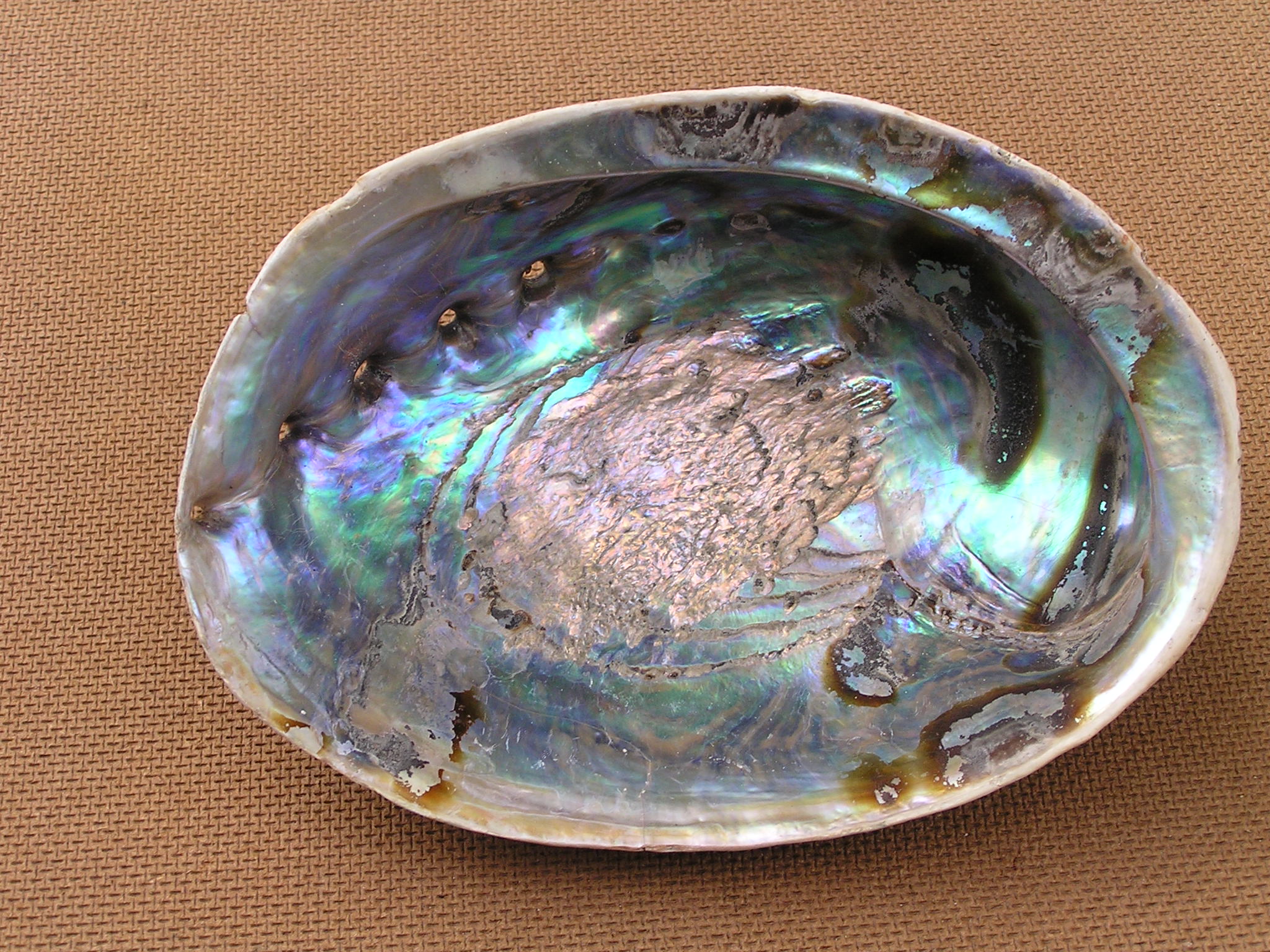|
Pāua
Pāua is the Māori name given to three New Zealand species of large edible sea snails, marine gastropod molluscs which belong to the family Haliotidae (in which there is only one genus, ''Haliotis''), known in the United States and Australia as abalone, and in the United Kingdom as ormer shells. Pāua has entered English through common use in the New Zealand English dialect, and is both singular and plural, following the grammar rules of its original language. Species There are three species of New Zealand pāua: New Zealand's best known pāua species is ''Haliotis iris''. It is also the most common species, growing up to 18 cm (7") in width Habitat Pāua are commonly found in shallow coastal waters along rocky shorelines in depths of 1 to 10 metres (3' to 30'). There is clear distinction between juvenile and adult habitats for ''Haliotis iris'', pāua less than 7 cm (3") occur in crevices and under stones in the shallow intertidal zone while adults are f ... [...More Info...] [...Related Items...] OR: [Wikipedia] [Google] [Baidu] |
Haliotis Australis
''Haliotis australis'', common name the "queen pāua," yellow-foot pāua, or austral abalone, is a species of edible sea snail, a marine gastropod mollusk in the family Haliotidae, the abalones. Description The size of the shell varies between 40 mm and 100 mm. "The thin, oval shell is quite convex. The distance of the apex from margin measures one-eighth to one-ninth the length of the shell. The sculpture consists of faint spirals and a close strong radiating corrugation. The 6 to 8 perforations are circular with elevated edges. The outlines are oval. The right margin is a little straighter. The back of the shell is convex, not carinated at the row of holes. The color pattern is light yellowish-brown, red on the spire, or light green flamed with red. The surface has almost obsolete spiral cords, and regular, close, radiating folds. Between the row of holes and the columellar margin there are no radiating folds, but several (generally three) strong spiral ribs. The spire ... [...More Info...] [...Related Items...] OR: [Wikipedia] [Google] [Baidu] |
Haliotis Virginea
''Haliotis virginea'', Virgin pāua, is a species of edible sea snail, a marine gastropod mollusk in the family Haliotidae, the abalones.Rosenberg, G. (2012). Haliotis virginea Gmelin, 1791. Accessed through: World Register of Marine Species at http://www.marinespecies.org/aphia.php?p=taxdetails&id=390555 on 2013-02-06 Description The size of the shell varies between 30 mm and 75 mm. Subspecies * ''Haliotis virginea crispata'' Gould, 1847 * ''Haliotis virginea huttoni'' Filhol, 1880 * ''Haliotis virginea morioria'' Powell, 1938 * ''Haliotis virginea stewartae'' Jones & Owen, 2004 DNA extracted from ''H. virginae'' shells in museums showed three main population divisions, inhabiting the Three Kings Islands; the Chatham, Auckland, and Antipodes Islands; and mainland New Zealand (as well as Campbell Island). These three clades do not correspond to the subspecies recognised above. Distribution This marine species is endemic to New Zealand. Human use ''Haliotis virgin ... [...More Info...] [...Related Items...] OR: [Wikipedia] [Google] [Baidu] |
Haliotidae
''Haliotis'', common name abalone, is the only genus in the family Haliotidae. This genus once contained six subgenera. These subgenera have become alternate representations of ''Haliotis''. The genus consists of small to very large, edible, herbivorous sea snails, marine gastropod molluscs. The number of species recognized worldwide ranges between 30 and 130, with over 230 species-level taxa described. The most comprehensive treatment of the family considers 56 species valid, with 18 additional subspecies. Other common names are ear shells, sea ears, and, rarely, muttonfish or muttonshells in parts of Australia, ormer in the UK, perlemoen in South Africa, and the Maori name for three species in New Zealand is pāua. Description The shells of abalones have a low, open, spiral structure, and are characterized by having several open respiratory pores in a row near the shell's outer edge. The thick inner layer of the shell is composed of nacre, which in many species of abalone i ... [...More Info...] [...Related Items...] OR: [Wikipedia] [Google] [Baidu] |
Haliotis
''Haliotis'', common name abalone, is the only genus in the family Haliotidae. This genus once contained six subgenera. These subgenera have become alternate representations of ''Haliotis''. The genus consists of small to very large, edible, herbivorous sea snails, marine gastropod molluscs. The number of species recognized worldwide ranges between 30 and 130, with over 230 species-level taxa described. The most comprehensive treatment of the family considers 56 species valid, with 18 additional subspecies. Other common names are ear shells, sea ears, and, rarely, muttonfish or muttonshells in parts of Australia, ormer in the UK, perlemoen in South Africa, and the Maori name for three species in New Zealand is pāua. Description The shells of abalones have a low, open, spiral structure, and are characterized by having several open respiratory pores in a row near the shell's outer edge. The thick inner layer of the shell is composed of nacre, which in many species of ab ... [...More Info...] [...Related Items...] OR: [Wikipedia] [Google] [Baidu] |
Haliotis Iris Shell 2
''Haliotis'', common name abalone, is the only genus in the family Haliotidae. This genus once contained six subgenera. These subgenera have become alternate representations of ''Haliotis''. The genus consists of small to very large, edible, herbivorous sea snails, marine gastropod molluscs. The number of species recognized worldwide ranges between 30 and 130, with over 230 species-level taxa described. The most comprehensive treatment of the family considers 56 species valid, with 18 additional subspecies. Other common names are ear shells, sea ears, and, rarely, muttonfish or muttonshells in parts of Australia, ormer in the UK, perlemoen in South Africa, and the Maori name for three species in New Zealand is pāua. Description The shells of abalones have a low, open, spiral structure, and are characterized by having several open respiratory pores in a row near the shell's outer edge. The thick inner layer of the shell is composed of nacre, which in many species of abalone i ... [...More Info...] [...Related Items...] OR: [Wikipedia] [Google] [Baidu] |
New Zealand
New Zealand ( mi, Aotearoa ) is an island country in the southwestern Pacific Ocean. It consists of two main landmasses—the North Island () and the South Island ()—and over 700 smaller islands. It is the sixth-largest island country by area, covering . New Zealand is about east of Australia across the Tasman Sea and south of the islands of New Caledonia, Fiji, and Tonga. The country's varied topography and sharp mountain peaks, including the Southern Alps, owe much to tectonic uplift and volcanic eruptions. New Zealand's capital city is Wellington, and its most populous city is Auckland. The islands of New Zealand were the last large habitable land to be settled by humans. Between about 1280 and 1350, Polynesians began to settle in the islands and then developed a distinctive Māori culture. In 1642, the Dutch explorer Abel Tasman became the first European to sight and record New Zealand. In 1840, representatives of the United Kingdom and Māori chiefs ... [...More Info...] [...Related Items...] OR: [Wikipedia] [Google] [Baidu] |
Marine (ocean)
The ocean (also the sea or the world ocean) is the body of salt water that covers approximately 70.8% of the surface of Earth and contains 97% of Earth's water. An ocean can also refer to any of the large bodies of water into which the world ocean is conventionally divided."Ocean." ''Merriam-Webster.com Dictionary'', Merriam-Webster, |
Ministry Of Primary Industries (New Zealand)
, logo = MPINZ-logo.svg , logo_width = , logo_caption = , picture = , picture_width = , picture_caption = , formed = , preceding1 = Ministry of Agriculture and Forestry , preceding2 = Ministry of Fisheries , preceding3 = New Zealand Food Safety Authority , dissolved = , superseding = , jurisdiction = New Zealand , headquarters = , region_code = , coordinates = , motto = , employees = , budget = Total budgets for 2019/20''Vote Agriculture, Biosecurity, Fisheries and Food Safety''$848,779,000''Vote Forestry''$277,099,000 , minister1_name = Damien O'Connor , minister1_pfo = Agriculture, Biosecurity, and Rural Communities , minister2_name = Stuart Nash , minister2_pfo = Forestry , minister3_name = David Parker , minister3_pfo = Oceans and Fisheries , minister4_name = Meka Whaitiri , minister4_pfo = Food ... [...More Info...] [...Related Items...] OR: [Wikipedia] [Google] [Baidu] |
Aquaculture
Aquaculture (less commonly spelled aquiculture), also known as aquafarming, is the controlled cultivation ("farming") of aquatic organisms such as fish, crustaceans, mollusks, algae and other organisms of value such as aquatic plants (e.g. lotus). Aquaculture involves cultivating freshwater, brackish water and saltwater populations under controlled or semi-natural conditions, and can be contrasted with commercial fishing, which is the harvesting of wild fish. Mariculture, commonly known as marine farming, refers specifically to aquaculture practiced in seawater habitats and lagoons, opposed to in freshwater aquaculture. Pisciculture is a type of aquaculture that consists of fish farming to obtain fish products as food. Aquaculture can also be defined as the breeding, growing, and harvesting of fish and other aquatic plants, also known as farming in water. It is an environmental source of food and commercial product which help to improve healthier habitats and used to recon ... [...More Info...] [...Related Items...] OR: [Wikipedia] [Google] [Baidu] |
Taonga
''Taonga'' or ''taoka'' (in South Island Māori) is a Maori-language word that refers to a treasured possession in Māori culture. It lacks a direct translation into English, making its use in the Treaty of Waitangi significant. The current definition differs from the historical one, noted by Hongi Hika as "property procured by the spear" war booty or defended property] and is now interpreted to mean a wide range of both tangible and intangible possessions, especially items of historical cultural significance. Tangible examples are all sorts of Antique, heirlooms and artefacts, land, fisheries, natural resources such as geothermal springs and access to natural resources, such as riparian water rights and access to the riparian zone of rivers or streams. Intangible examples may include language and spiritual beliefs. What is deemed to be a ''taonga'' has major political, economic and social consequences in New Zealand and has been the subject of fierce debates as the varying ... [...More Info...] [...Related Items...] OR: [Wikipedia] [Google] [Baidu] |
New Zealand Police
The New Zealand Police ( mi, Ngā Pirihimana o Aotearoa) is the national police service and principal law enforcement agency of New Zealand, responsible for preventing crime, enhancing public safety, bringing offenders to justice, and maintaining public order. With about 13,000 personnel, it is the largest law enforcement agency in New Zealand and, with few exceptions, has primary jurisdiction over the majority of New Zealand criminal law. The New Zealand Police also has responsibility for traffic and commercial vehicle enforcement as well as other key responsibilities including protection of dignitaries, firearms licensing, and matters of national security. Policing in New Zealand was introduced in 1840, modelled on similar constabularies that existed in Britain at that time. The constabulary was initially part police and part militia. By the end of the 19th century policing by consent was the goal. The New Zealand Police has generally enjoyed a reputation for mild policin ... [...More Info...] [...Related Items...] OR: [Wikipedia] [Google] [Baidu] |

_from_New_Zealand.jpg)


